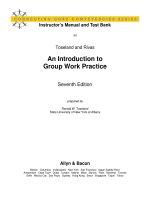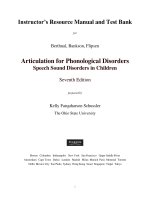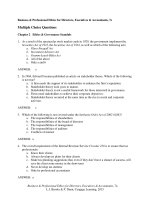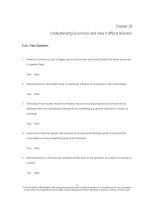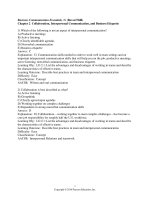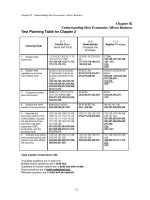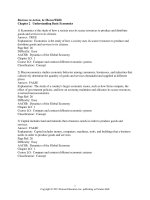Business statistics in practice 7th edition bowerman test bank
Bạn đang xem bản rút gọn của tài liệu. Xem và tải ngay bản đầy đủ của tài liệu tại đây (4.2 MB, 120 trang )
Chapter 02
Descriptive Statistics: Tabular and Graphical Methods
True / False Questions
1.
A stem-and-leaf display is a graphical portrayal of a data set that shows the data set's overall
pattern of variation.
True
2.
The relative frequency is the frequency of a class divided by the total number of measurements.
True
3.
False
A scatter plot can be used to identify outliers.
True
6.
False
Stem-and-leaf displays and dot plots are useful for detecting outliers.
True
5.
False
A bar chart is a graphic that can be used to depict qualitative data.
True
4.
False
False
When looking at the shape of the distribution using a stem-and-leaf, a distribution is skewed to the
right when the left tail is shorter than the right tail.
True
False
2-1
© 2014 by McGraw-Hill Education. This is proprietary material solely for authorized instructor use. Not authorized for sale or distribution in
any manner. This document may not be copied, scanned, duplicated, forwarded, distributed, or posted on a website, in whole or part.
7.
When we wish to summarize the proportion (or fraction) of items in a class, we use the frequency
distribution for each class.
True
8.
False
When establishing the classes for a frequency table, it is generally agreed that the more classes you
use the better your frequency table will be.
True
9.
False
The sample cumulative distribution function is nondecreasing.
True
False
10. A frequency table includes row and column percentages.
True
False
11. When constructing any graphical display that utilizes categorical data, classes that have frequencies
of 5 percent or less are usually combined together into a single category.
True
False
12. In a Pareto chart, the bar for the "Other" category should be placed to the far left of the chart.
True
False
13. In the first step of setting up a Pareto chart, a frequency table should be constructed of the defects
(or categories) in decreasing order of frequency.
True
False
14. It is possible to create different interpretations of the same graphical display by simply using
different captions.
True
False
2-2
© 2014 by McGraw-Hill Education. This is proprietary material solely for authorized instructor use. Not authorized for sale or distribution in
any manner. This document may not be copied, scanned, duplicated, forwarded, distributed, or posted on a website, in whole or part.
15. Beginning the vertical scale of a graph at a value different from zero can cause increases to look
more dramatic.
True
False
16. A runs plot is a form of scatter plot.
True
False
17. The stem-and-leaf display is advantageous because it allows us to actually see the measurements in
the data set.
True
False
18. Splitting the stems refers to assigning the same stem to two or more rows of the stem-and-leaf
display.
True
False
19. When data are qualitative, the bars should never be separated by gaps.
True
False
20. Each stem of a stem-and-leaf display should be a single digit.
True
False
21. Leaves on a stem-and-leaf display should be rearranged so that they are in increasing order from
left to right.
True
False
Multiple Choice Questions
2-3
© 2014 by McGraw-Hill Education. This is proprietary material solely for authorized instructor use. Not authorized for sale or distribution in
any manner. This document may not be copied, scanned, duplicated, forwarded, distributed, or posted on a website, in whole or part.
22. A(n) ______ is a graph of a cumulative distribution.
A. Histogram
B. Scatter plot
C. Ogive plot
D. Pie chart
23. ________ can be used to study the relationship between two variables.
A. Cross-tabulation tables
B. Frequency tables
C. Cumulative frequency distributions
D. Dot plots
24. Row or column percentages can be found in
A. Frequency tables.
B. Relative frequency tables.
C. Cross-tabulation tables.
D. Cumulative frequency tables.
25. All of the following are used to describe quantitative data except the ___________.
A. Histogram
B. Stem-and-leaf chart
C. Dot plot
D. Pie chart
2-4
© 2014 by McGraw-Hill Education. This is proprietary material solely for authorized instructor use. Not authorized for sale or distribution in
any manner. This document may not be copied, scanned, duplicated, forwarded, distributed, or posted on a website, in whole or part.
26. An observation separated from the rest of the data is a(n) ___________.
A. Absolute extreme
B. Outlier
C. Mode
D. Quartile
27. Which of the following graphs is for qualitative data?
A. Histogram
B. Bar chart
C. Ogive plot
D. Stem-and-leaf
28. A plot of the values of two variables is a _____ plot.
A. Runs
B. Scatter
C. Dot
D. Ogive
29. A Stem-and-leaf display is best used to ___________.
A. Provide a point estimate of the variability of the data set
B. Provide a point estimate of the central tendency of the data set
C. Display the shape of the distribution
D. None of these
2-5
© 2014 by McGraw-Hill Education. This is proprietary material solely for authorized instructor use. Not authorized for sale or distribution in
any manner. This document may not be copied, scanned, duplicated, forwarded, distributed, or posted on a website, in whole or part.
30. When grouping a large sample of measurements into classes, the ______________ is a better tool
than the ___________.
A. Histogram, stem-and-leaf display
B. Box plot, histogram
C. Stem-and-leaf display, scatter plot
D. Scatter plot, box plot
31. A _____________ displays the frequency of each group with qualitative data and a _____________
displays the frequency of each group with quantitative data.
A. Histogram, stem-and-leaf display
B. Bar chart, histogram
C. Scatter plot, bar chart
D. Stem-and-leaf, pie chart
32. A ______________ shows the relationship between two variables.
A. Stem-and-leaf
B. Bar chart
C. Histogram
D. Scatter plot
E. Pie chart
33. A ______________ can be used to differentiate the "vital few" causes of quality problems from the
"trivial many" causes of quality problems.
A. Histogram
B. Scatter plot
C. Pareto chart
D. Ogive plot
E. Stem-and-leaf display
2-6
© 2014 by McGraw-Hill Education. This is proprietary material solely for authorized instructor use. Not authorized for sale or distribution in
any manner. This document may not be copied, scanned, duplicated, forwarded, distributed, or posted on a website, in whole or part.
34. ______________ and _____________ are used to describe qualitative (categorical) data.
A. Stem-and-leaf displays, scatter plots
B. Scatter plots, histograms
C. Box plots, bar charts
D. Bar charts, pie charts
E. Pie charts, histograms
35. Which one of the following graphical tools is used with quantitative data?
A. Bar chart
B. Histogram
C. Pie chart
D. Pareto chart
36. When developing a frequency distribution, the class (group) intervals should be ___________.
A. Large
B. Small
C. Integer
D. Mutually exclusive
E. Equal
37. Which of the following graphical tools is not used to study the shapes of distributions?
A. Stem-and-leaf display
B. Scatter plot
C. Histogram
D. Dot plot
2-7
© 2014 by McGraw-Hill Education. This is proprietary material solely for authorized instructor use. Not authorized for sale or distribution in
any manner. This document may not be copied, scanned, duplicated, forwarded, distributed, or posted on a website, in whole or part.
38. All of the following are used to describe qualitative data except the ___________.
A. Bar chart
B. Pie chart
C. Histogram
D. Pareto chart
39. If there are 130 values in a data set, how many classes should be created for a frequency
histogram?
A. 4
B. 5
C. 6
D. 7
E. 8
40. If there are 120 values in a data set, how many classes should be created for a frequency
histogram?
A. 4
B. 5
C. 6
D. 7
E. 8
41. If there are 62 values in a data set, how many classes should be created for a frequency histogram?
A. 4
B. 5
C. 6
D. 7
E. 8
2-8
© 2014 by McGraw-Hill Education. This is proprietary material solely for authorized instructor use. Not authorized for sale or distribution in
any manner. This document may not be copied, scanned, duplicated, forwarded, distributed, or posted on a website, in whole or part.
42. If there are 30 values in a data set, how many classes should be created for a frequency histogram?
A. 4
B. 5
C. 6
D. 7
E. 8
43. A CFO is looking at how much of a company's resources are spent on computing. He samples
companies in the pharmaceutical industry and develops the following stem-and-leaf graph.
What is the approximate shape of the distribution of the data?
A. Normal
B. Skewed to the right
C. Skewed to the left
D. Bimodal
E. Uniform
2-9
© 2014 by McGraw-Hill Education. This is proprietary material solely for authorized instructor use. Not authorized for sale or distribution in
any manner. This document may not be copied, scanned, duplicated, forwarded, distributed, or posted on a website, in whole or part.
44. A CFO is looking at how much of a company's resources are spent on computing. He samples
companies in the pharmaceutical industry and develops the following stem-and-leaf graph.
What is the smallest percentage spent on R&D?
A. 5.9
B. 5.6
C. 5.2
D. 5.02
E. 50.2
2-10
© 2014 by McGraw-Hill Education. This is proprietary material solely for authorized instructor use. Not authorized for sale or distribution in
any manner. This document may not be copied, scanned, duplicated, forwarded, distributed, or posted on a website, in whole or part.
45. A CFO is looking at how much of a company's resources are spent on computing. He samples
companies in the pharmaceutical industry and develops the following stem-and-leaf graph.
If you were creating a frequency histogram using these data, how many classes would you create?
A. 4
B. 5
C. 6
D. 7
E. 8
2-11
© 2014 by McGraw-Hill Education. This is proprietary material solely for authorized instructor use. Not authorized for sale or distribution in
any manner. This document may not be copied, scanned, duplicated, forwarded, distributed, or posted on a website, in whole or part.
46. A CFO is looking at how much of a company's resources are spent on computing. He samples
companies in the pharmaceutical industry and develops the following stem-and-leaf graph.
What would be the class length used in creating a frequency histogram?
A. 1.4
B. 8.3
C. 1.2
D. 1.7
E. 0.9
2-12
© 2014 by McGraw-Hill Education. This is proprietary material solely for authorized instructor use. Not authorized for sale or distribution in
any manner. This document may not be copied, scanned, duplicated, forwarded, distributed, or posted on a website, in whole or part.
47. A CFO is looking at how much of a company's resources are spent on computing. He samples
companies in the pharmaceutical industry and develops the following stem-and-leaf graph.
What would be the first class interval for the frequency histogram?
A. 5.2-6.5
B. 5.2-6.0
C. 5.0-6.0
D. 5.2-6.6
E. 5.2-6.4
2-13
© 2014 by McGraw-Hill Education. This is proprietary material solely for authorized instructor use. Not authorized for sale or distribution in
any manner. This document may not be copied, scanned, duplicated, forwarded, distributed, or posted on a website, in whole or part.
48. The US local airport keeps track of the percentage of flights arriving within 15 minutes of their
scheduled arrivals. The stem-and-leaf plot of the data for one year is below.
How many flights were used in this plot?
A. 7
B. 9
C. 10
D. 11
E. 12
2-14
© 2014 by McGraw-Hill Education. This is proprietary material solely for authorized instructor use. Not authorized for sale or distribution in
any manner. This document may not be copied, scanned, duplicated, forwarded, distributed, or posted on a website, in whole or part.
49. The US local airport keeps track of the percentage of flights arriving within 15 minutes of their
scheduled arrivals. The stem-and-leaf plot of the data for one year is below.
In developing a histogram of these data, how many classes would be used?
A. 4
B. 5
C. 6
D. 7
E. 8
2-15
© 2014 by McGraw-Hill Education. This is proprietary material solely for authorized instructor use. Not authorized for sale or distribution in
any manner. This document may not be copied, scanned, duplicated, forwarded, distributed, or posted on a website, in whole or part.
50. The US local airport keeps track of the percentage of flights arriving within 15 minutes of their
scheduled arrivals. The stem-and-leaf plot of the data for one year is below.
What would be the class length for creating the frequency histogram?
A. 1.4
B. 0.8
C. 2.7
D. 1.7
E. 2.3
51. A company collected the ages from a random sample of its middle managers, with the resulting
frequency distribution shown below.
What would be the approximate shape of the relative frequency histogram?
A. Symmetrical
B. Uniform
C. Multiple peaks
D. Skewed to the left
E. Skewed to the right
2-16
© 2014 by McGraw-Hill Education. This is proprietary material solely for authorized instructor use. Not authorized for sale or distribution in
any manner. This document may not be copied, scanned, duplicated, forwarded, distributed, or posted on a website, in whole or part.
52. A company collected the ages from a random sample of its middle managers, with the resulting
frequency distribution shown below.
What is the relative frequency for the largest interval?
A. .132
B. .226
C. .231
D. .283
E. .288
53. A company collected the ages from a random sample of its middle managers, with the resulting
frequency distribution shown below.
What is the midpoint of the third class interval?
A. 22.5
B. 27.5
C. 32.5
D. 37.5
E. 42.5
2-17
© 2014 by McGraw-Hill Education. This is proprietary material solely for authorized instructor use. Not authorized for sale or distribution in
any manner. This document may not be copied, scanned, duplicated, forwarded, distributed, or posted on a website, in whole or part.
54. The general term for a graphical display of categorical data made up of vertical or horizontal bars is
called a(n) ___________.
A. Pie chart
B. Pareto chart
C. Bar chart
D. Ogive plot
55. A flaw possessed by a population or sample unit is ___________.
A. Always random
B. A defect
C. Displayed by a dot plot
D. The cause for extreme skewness to the right
56. A graphical portrayal of a quantitative data set that divides the data into classes and gives the
frequency of each class is a(n) ___________.
A. Ogive plot
B. Dot plot
C. Histogram
D. Pareto chart
E. Bar chart
57. The number of measurements falling within a class interval is called the ___________.
A. Frequency
B. Relative frequency
C. Leaf
D. Cumulative sum
2-18
© 2014 by McGraw-Hill Education. This is proprietary material solely for authorized instructor use. Not authorized for sale or distribution in
any manner. This document may not be copied, scanned, duplicated, forwarded, distributed, or posted on a website, in whole or part.
58. A relative frequency curve having a long tail to the right is said to be ___________.
A. Skewed to the left
B. Normal
C. A scatter plot
D. Skewed to the right
59. The percentage of measurements in a class is called the ___________ of that class.
A. Frequency
B. Relative frequency
C. Leaf
D. Cumulative percentage
60. A histogram that tails out toward larger values is ___________.
A. Skewed to the left
B. Normal
C. A scatter plot
D. Skewed to the right
61. A histogram that tails out toward smaller values is ___________.
A. Skewed to the left
B. Normal
C. A scatter plot
D. Skewed to the right
2-19
© 2014 by McGraw-Hill Education. This is proprietary material solely for authorized instructor use. Not authorized for sale or distribution in
any manner. This document may not be copied, scanned, duplicated, forwarded, distributed, or posted on a website, in whole or part.
62. A very simple graph that can be used to summarize a quantitative data set is called a(n)
___________.
A. Runs plot
B. Ogive plot
C. Dot plot
D. Pie chart
63. An example of manipulating a graphical display to distort reality is ___________.
A. Starting the axes at zero
B. Making the bars in a histogram equal widths
C. Stretching the axes
D. Starting the axes at zero and Stretching the axes
64. As a general rule, when creating a stem-and-leaf display, there should be ______ stem values.
A. Between 3 and 10
B. Between 1 and 100
C. No fewer than 20
D. Between 5 and 20
2-20
© 2014 by McGraw-Hill Education. This is proprietary material solely for authorized instructor use. Not authorized for sale or distribution in
any manner. This document may not be copied, scanned, duplicated, forwarded, distributed, or posted on a website, in whole or part.
65. At the end of their final exam, 550 students answered an additional question in which they rated
their instructor's teaching effectiveness, with the following results.
What proportion of the students who rated their instructor as very or somewhat effective received a
B or better in the class?
A. 0.345
B. 0.254
C. 0.482
D. 0.898
E. 0.644
2-21
© 2014 by McGraw-Hill Education. This is proprietary material solely for authorized instructor use. Not authorized for sale or distribution in
any manner. This document may not be copied, scanned, duplicated, forwarded, distributed, or posted on a website, in whole or part.
66. At the end of their final exam, 550 students answered an additional question in which they rated
their instructor's teaching effectiveness, with the following results.
What proportion of all 550 students received less than a C?
A. 0.03
B. 0.06
C. 0.08
D. 0.13
E. 0.15
2-22
© 2014 by McGraw-Hill Education. This is proprietary material solely for authorized instructor use. Not authorized for sale or distribution in
any manner. This document may not be copied, scanned, duplicated, forwarded, distributed, or posted on a website, in whole or part.
67. 822 customers were randomly selected from those who had recently bought a book over the
Internet. The chart below shows the breakdown of the classification of the book type.
What percentage of the books purchased were either mystery or science fiction/fantasy?
A. 18.61
B. 36.50
C. 17.88
D. 24.33
E. 22.99
2-23
© 2014 by McGraw-Hill Education. This is proprietary material solely for authorized instructor use. Not authorized for sale or distribution in
any manner. This document may not be copied, scanned, duplicated, forwarded, distributed, or posted on a website, in whole or part.
68. 822 customers were randomly selected from those who had recently bought a book over the
Internet. The chart below shows the breakdown of the classification of the book type.
What percentage of the books purchased were self-help books?
A. 11.44
B. .1144
C. 1.82
D. 0.0182
E. 0.940
2-24
© 2014 by McGraw-Hill Education. This is proprietary material solely for authorized instructor use. Not authorized for sale or distribution in
any manner. This document may not be copied, scanned, duplicated, forwarded, distributed, or posted on a website, in whole or part.
69. 822 customers were randomly selected from those who had recently bought a book over the
Internet. The chart below shows the breakdown of the classification of the book type.
What percentage of the books were in the top two categories?
A. 22.99
B. 20.44
C. 4.50
D. 43.43
E. 0.4343
2-25
© 2014 by McGraw-Hill Education. This is proprietary material solely for authorized instructor use. Not authorized for sale or distribution in
any manner. This document may not be copied, scanned, duplicated, forwarded, distributed, or posted on a website, in whole or part.
